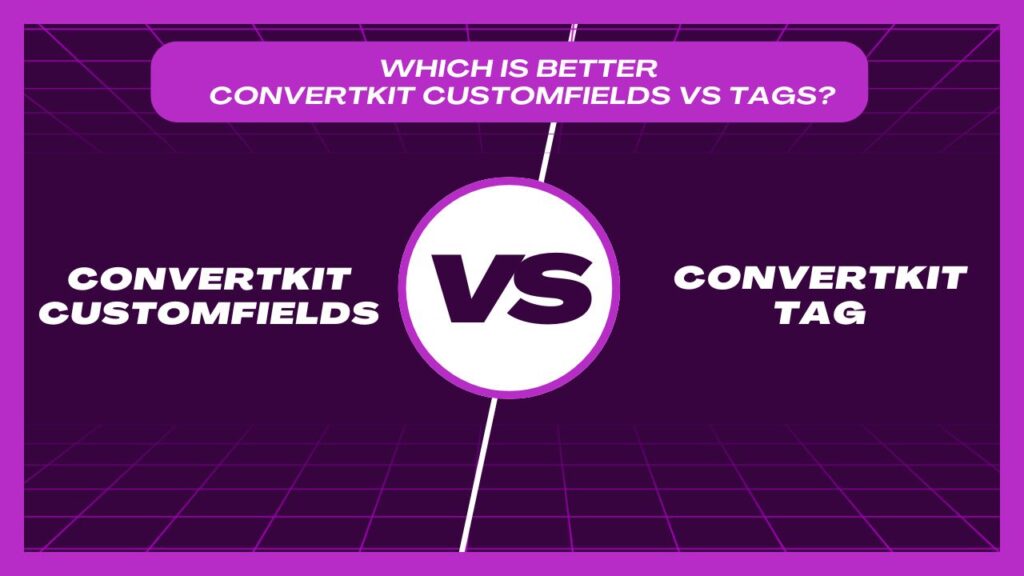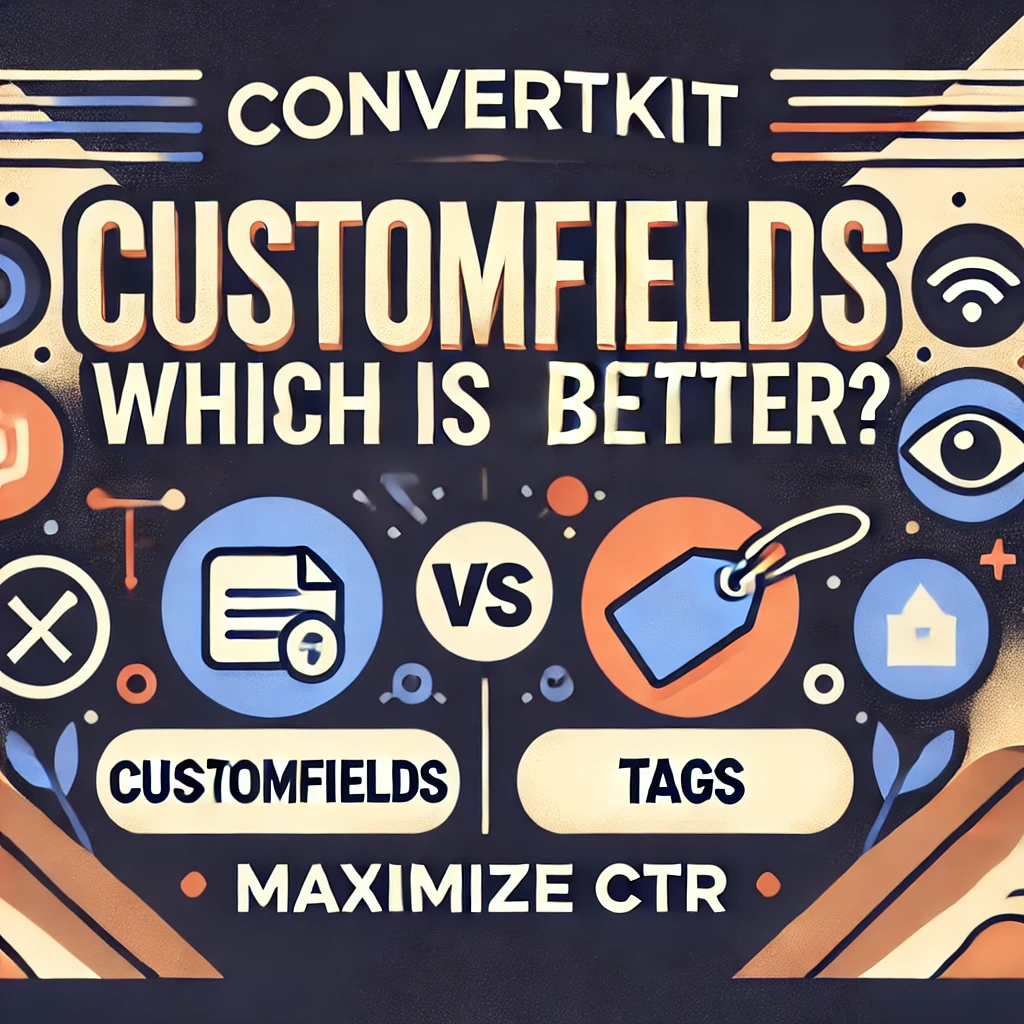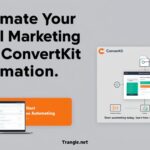ConvertKit Customfields vs Tags: Find the Best Way to Organize Your Email List for Higher Engagement

Why Audience Segmentation Matters
Are you struggling to keep your email lists organized? If so, you’re not alone. Many marketers face the challenge of creating personalized, effective email campaigns, only to find that generic messages aren’t resonating with their audience. The right segmentation can make all the difference—ensuring that your message reaches the right people at the right time.
ConvertKit offers two powerful ways to organize your subscribers: custom fields and tags. Each has unique strengths designed to enhance your email marketing efforts, but which one is right for you? Let’s dive in to discover how these features work and how they can help you transform your email engagement.
Understanding Custom Fields vs Tags in ConvertKit
ConvertKit’s custom fields and tags both play a crucial role in helping you better understand your audience and communicate more effectively. While custom fields allow you to store specific subscriber data, tags enable you to categorize subscribers based on actions, interests, or other factors.
So how do you decide which option to use? Here’s a breakdown to help guide your decision.
Real-Life Success Story: How Sarah Boosted Engagement with ConvertKit’s Segmentation Features
Meet Sarah, an eCommerce entrepreneur. Just a few months ago, she was frustrated with her low email engagement and declining open rates. Her emails felt generic, and subscribers weren’t connecting with her content.
Then, Sarah discovered ConvertKit’s segmentation tools. By setting up custom fields to capture key details about her subscribers’ preferences and using tags to track behaviors like recent purchases and website visits, Sarah was able to send highly targeted messages that spoke to each individual’s needs.
Within weeks, Sarah saw a 30% increase in open rates and a 20% higher click-through rate. Her emails finally resonated with her audience, and her customers responded enthusiastically.
ConvertKit Customfields vs Tags: How Do They Work?
Custom Fields: Store Unique Subscriber Data for Personalization
Custom fields allow you to collect and store specific data points for each subscriber. This might include details such as:
- First and last name
- Location
- Birthday
- Product preferences
- Purchase history
By using this information, you can personalize your email content to a higher degree. For example, you could address subscribers by name, recommend products based on previous purchases, or send a special birthday message. Custom fields make it possible to craft messages tailored to each subscriber.
Tags: Group Subscribers Based on Actions and Interests
Tags are flexible labels that help you categorize subscribers by their behaviors or interests. Here are some ways to use tags effectively:
- Tracking interactions (e.g., subscribers who clicked on a specific link)
- Categorizing interests (e.g., “Digital Marketing” vs. “Ecommerce”)
- Noting subscriber status (e.g., “New Subscriber,” “Engaged,” “Inactive”)
Tags provide a simple way to organize your subscribers without requiring unique data for each one. This makes tags ideal for broader segmentation based on behavior and engagement.
Deciding When to Use ConvertKit Customfields vs Tags
So, which should you use: custom fields or tags? The answer depends on your goals:
- Choose custom fields if you need detailed data about each subscriber to personalize emails on an individual level.
- Choose tags if you want a flexible way to group subscribers by actions or interests.
For most marketers, a combination of both is the best approach, allowing for more precise targeting and flexibility.
Benefits of Using Custom Fields vs Tags in ConvertKit
| Feature | Benefit |
| Custom Fields | Allows you to store specific subscriber data, enabling personalized email content. |
| Tags | Lets you categorize subscribers based on behavior or interests for easy segmentation. |
| Automation Compatibility | Works seamlessly with ConvertKit’s automation, triggering targeted emails based on fields or tags. |
| Ease of Use | ConvertKit’s user-friendly interface makes setting up segmentation simple, even for beginners. |
Success Stories: Proven Results with ConvertKit’s Segmentation Tools
Marketers who use ConvertKit for segmentation have reported substantial improvements in engagement. Businesses that implemented both custom fields and tags saw a 29% average increase in engagement.
Here’s what one ConvertKit user had to say:
“After setting up custom fields and tags, my open rates have never been higher. My emails finally feel ‘personal’ to my audience.”
Comparing ConvertKit with Alternatives
Many email marketing tools, like Mailchimp and Constant Contact, offer tags and basic segmentation, but ConvertKit stands out for its flexible and precise approach. With ConvertKit, you can combine both custom fields and tags, allowing for a level of audience targeting that other tools simply don’t match.
Start Your ConvertKit Journey
Ready to take your email marketing to the next level? Start using ConvertKit today to unlock the full potential of custom fields and tags, and watch your email engagement soar.
ConvertKit’s intuitive interface makes it easy for beginners to get started with segmentation. With a wealth of tutorials and support resources, you can set up custom fields and tags without any technical expertise.
Common Questions About ConvertKit’s Custom Fields vs Tags
Is ConvertKit difficult to use if I’m new to email marketing?
ConvertKit is designed for ease of use, even if you’re a beginner. The platform offers an intuitive interface and a wealth of tutorials to help you get started quickly.
Is ConvertKit worth the investment?
ConvertKit is an investment in building stronger relationships with your subscribers. With custom fields and tags, you can create highly personalized emails that improve engagement, loyalty, and ultimately, conversions.
What is the difference between custom field and tag in ConvertKit?
Custom Fields:
Purpose: Store unique, specific data about each subscriber.
Examples: First name, location, purchase history, preferences.
Use: Personalize emails and enable dynamic content. Custom fields hold persistent information about subscribers.
Tags:
Purpose: Work as binary labels (either assigned or not) to track actions or status.
Examples: “Clicked-summer-sale,” “attended-webinar,” “active-customer.”
Use: Segmentation and automation. Tags are added or removed based on subscriber actions and help trigger automated workflows.
When to Use Custom Fields vs Tags in ConvertKit?
Use Custom Fields When:
Storing specific subscriber information like birthdays, company names, or product preferences.
Personalizing email content for each subscriber.
Collecting structured, unique data that will be referenced repeatedly.
Use Tags When:
Tracking subscriber behavior and segmenting based on actions.
Automating workflows (e.g., marking completion of a purchase or webinar attendance).
Setting up quick labels to note stages in the customer journey, like “new subscriber” or “VIP.”
Benefits of Using ConvertKit Custom Fields vs Tags
Custom Fields:
Enhanced Personalization: Use specific subscriber data for highly personalized emails.
Better Data Organization: Organize structured data for complex segmentation and efficient targeting.
Improved Targeting: Create segments based on specific data points like preferences or past purchases.
Tags:
Efficient Segmentation: Quickly group subscribers based on behavior and manage the customer journey.
Powerful Automation: Easily trigger automated sequences and track engagement.
Simple Implementation: Tags are easy to set up and manage, ideal for changing marketing needs.
How Do ConvertKit Custom Fields and Tags Work Together?
Combining custom fields and tags enables powerful marketing strategies:
Integration Examples:
1. Purchase Tracking:
Custom Field: Store purchase amount.
Tag: Mark as “customer.”
Result: Target high-value customers with tailored offers.1
2. Course Delivery:
Custom Field: Track course progress.
Tag: Mark completed modules.
Result: Send personalized follow-ups and support based on progress.
3. Content Preferences:
Custom Field: Store content interests.
Tag: Track engagement with specific topics.
Result: Deliver more relevant content.
4. Automation Workflow Example:
IF subscriber clicks a link
THEN add tag “interested-in-product”
AND update custom field “last_interaction_date”
THEN send a personalized follow-up email using both data points.
Common Use Cases for ConvertKit Custom Fields vs Tags
Custom Field Applications:
Subscriber Information: First name, birthday, location, etc.
Preferences: Content topics, product interests, preferred communication frequency.
Purchase Data: Total spend, last purchase date, cart value.
Tag Applications:
Subscriber Journey: “New-Subscriber,” “Product-Purchased,” “Course-Completed.”
Engagement Levels: “Highly-Engaged,” “At-Risk,” “Inactive,” “VIP-Customer.”
Campaign Interaction: “Clicked-Promo-Link,” “Watched-Webinar,” “Visited-Sales-Page.”
Don’t Miss Out on Better Engagement
Now’s the time to improve your email marketing strategy. Join thousands of satisfied ConvertKit users who have transformed their audience segmentation. Start today and experience the benefits in your next campaign!
Final Summary: Why ConvertKit’s Custom Fields and Tags Are Essential for Marketers
In summary, ConvertKit’s custom fields and tags offer a powerful solution for marketers looking to enhance their email engagement. By organizing your subscribers in a way that fits your strategy, you can send messages that resonate on a personal level, building stronger connections and loyalty.
If you’re ready to boost your email engagement, give ConvertKit’s custom fields and tags a try and see the results for yourself.











1 thought on “ConvertKit Customfields vs Tags: Which is Better for Your Needs in 2024?”